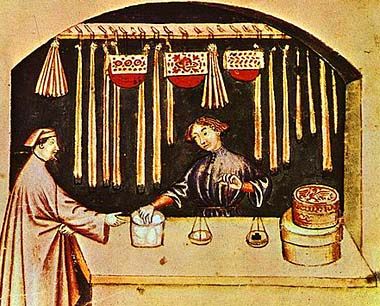With electricity still far in the future, Medieval lighting came in the form of fire. Rush lights were the simplest and cheapest form of lighting, though they weren’t particularly bright. Wild rushes were gathered, dried, then stripped of their skins. They were then soaked in animal fat, which left the rush itself to serve as a wick that could be lit. As many as needed were placed around the home to give off light.
 Candles were the next step up from rush lighting—they were brighter and lasted longer than rushes. Tallow candles were the most common type. These were made from tallow (animal fat) that was boiled and strained, turning creamy white once it had cooled and hardened again. The best type to use was from sheep, the next best from cows. Fiber strands were twisted into wicks that were dipped into the melted tallow over and over again until the candle shape was gradually formed. These types of wicks were not like modern ones that completely burn up as the wax melts away. They had to be trimmed at regular intervals. Tallow candles were easy to produce, but there were some drawbacks. The process of making, and burning, tallow candles was very smelly. These candles were also drippy and produced a lot of smoke that left soot stains on everything around them.
Candles were the next step up from rush lighting—they were brighter and lasted longer than rushes. Tallow candles were the most common type. These were made from tallow (animal fat) that was boiled and strained, turning creamy white once it had cooled and hardened again. The best type to use was from sheep, the next best from cows. Fiber strands were twisted into wicks that were dipped into the melted tallow over and over again until the candle shape was gradually formed. These types of wicks were not like modern ones that completely burn up as the wax melts away. They had to be trimmed at regular intervals. Tallow candles were easy to produce, but there were some drawbacks. The process of making, and burning, tallow candles was very smelly. These candles were also drippy and produced a lot of smoke that left soot stains on everything around them.
Though tallow candles could be made at home when animals were slaughtered, they were only made in large quantities by chandlers. The making of tallow candles and tallow soaps was often a side business of butchers. Though their products were in high demand, these shops were widely avoided due to the unpleasant odors they produced.
 The nobility and the church had access to a different type of candle that was more expensive and of far better quality than tallow—beeswax. They burned the brightest of all the candle types, and lasted longer. They were produced in a similar way than tallow, but did not smell and burned clean. Just as making tallow candles were a natural side business for butchers, beeswax candles were often made by bee keepers. Since these types of candles were favored by the nobility, and burned exclusively by the church, making beeswax candles was a highly profitable business.
The nobility and the church had access to a different type of candle that was more expensive and of far better quality than tallow—beeswax. They burned the brightest of all the candle types, and lasted longer. They were produced in a similar way than tallow, but did not smell and burned clean. Just as making tallow candles were a natural side business for butchers, beeswax candles were often made by bee keepers. Since these types of candles were favored by the nobility, and burned exclusively by the church, making beeswax candles was a highly profitable business.
Oil lamps were also used for lighting, but only in southern regions of Europe where oil was easy to come by, and the weather was warm enough that it would not solidify.
Some candles could also be used as clocks. They would be made to a specific thickness, and the person watching them would have to know how far down they would burn in a certain amount of time.
Larger than candles or lamps were torches, which could be fixed to walls, carried, or staked into the ground. They were typically made from branches or bound sticks made of green or wet wood that would not quickly burn down. Rags would be bound on one end, then soaked in something flammable like pitch, oil, animal fat, or tree sap. Like tallow, torches did not burn clean and had an odor that varied depending on which flammable substance was used. Torches gave off a lot of light by comparison to candles, but had to be replaced often as they burned out.
I’ve included a short video that talks about medieval chandlers and the process of making candles. Some of the information is repetitive, but it adds some nice visuals. Enjoy!
Learn more about the daily life in Middle Ages by browsing previous posts in the Medieval Monday Index.
One thought on “Medieval Monday: Lighting”